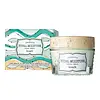What's inside
What's inside
 Key Ingredients
Key Ingredients

 Benefits
Benefits

 Concerns
Concerns

 Ingredients Side-by-side
Ingredients Side-by-side

Water
Skin ConditioningDicaprylyl Carbonate
EmollientHydrogenated Lanolin
EmollientSqualane
EmollientGlycerin
HumectantMethyl Trimethicone
Skin ConditioningGlyceryl Stearate
EmollientStearyl Alcohol
EmollientPEG-8
HumectantPentylene Glycol
Skin ConditioningCaprylic/Capric/Succinic Triglyceride
EmollientCeteth-20
CleansingEthylhexyl Palmitate
EmollientDimethicone
EmollientBetaine
HumectantDecyloxazolidinone
AntimicrobialPhenoxyethanol
PreservativeCetyl Alcohol
EmollientPalmitic Acid
EmollientStearic Acid
CleansingParfum
MaskingSteareth-25
CleansingMangifera Indica Seed Butter
Skin ConditioningSteareth-21
CleansingTetrasodium EDTA
Tocopheryl Acetate
AntioxidantCarbomer
Emulsion StabilisingXylitylglucoside
HumectantSorbitol
HumectantLinalool
PerfumingAnhydroxylitol
HumectantSodium Hydroxide
BufferingAlgin
MaskingXylitol
HumectantHexyl Cinnamal
PerfumingLimonene
PerfumingPolyvinyl Alcohol
Cellulose Gum
Emulsion StabilisingTocopherol
AntioxidantBHT
AntioxidantWater, Dicaprylyl Carbonate, Hydrogenated Lanolin, Squalane, Glycerin, Methyl Trimethicone, Glyceryl Stearate, Stearyl Alcohol, PEG-8, Pentylene Glycol, Caprylic/Capric/Succinic Triglyceride, Ceteth-20, Ethylhexyl Palmitate, Dimethicone, Betaine, Decyloxazolidinone, Phenoxyethanol, Cetyl Alcohol, Palmitic Acid, Stearic Acid, Parfum, Steareth-25, Mangifera Indica Seed Butter, Steareth-21, Tetrasodium EDTA, Tocopheryl Acetate, Carbomer, Xylitylglucoside, Sorbitol, Linalool, Anhydroxylitol, Sodium Hydroxide, Algin, Xylitol, Hexyl Cinnamal, Limonene, Polyvinyl Alcohol, Cellulose Gum, Tocopherol, BHT
Water
Skin ConditioningGlycerin
HumectantButyrospermum Parkii Butter
Skin ConditioningCetyl Alcohol
EmollientSimmondsia Chinensis Seed Oil
EmollientC10-18 Triglycerides
EmollientGlyceryl Stearate Citrate
EmollientC15-19 Alkane
SolventSalvia Hispanica Seed Oil
MoisturisingSambucus Nigra Fruit Juice
AstringentSodium PCA
HumectantSodium Hyaluronate
HumectantSimmondsia Chinensis Seed Extract
AbrasiveEpilobium Angustifolium Flower/Leaf/Stem Extract
Skin Conditioning1,2-Hexanediol
Skin ConditioningCaprylyl Glycol
EmollientHydroxyacetophenone
AntioxidantHydrogenated Lecithin
EmulsifyingLecithin
EmollientButylene Glycol
HumectantXanthan Gum
EmulsifyingCarbomer
Emulsion StabilisingAlcohol
AntimicrobialPolyglyceryl-3 Stearate
EmulsifyingSodium Hydroxide
BufferingWater, Glycerin, Butyrospermum Parkii Butter, Cetyl Alcohol, Simmondsia Chinensis Seed Oil, C10-18 Triglycerides, Glyceryl Stearate Citrate, C15-19 Alkane, Salvia Hispanica Seed Oil, Sambucus Nigra Fruit Juice, Sodium PCA, Sodium Hyaluronate, Simmondsia Chinensis Seed Extract, Epilobium Angustifolium Flower/Leaf/Stem Extract, 1,2-Hexanediol, Caprylyl Glycol, Hydroxyacetophenone, Hydrogenated Lecithin, Lecithin, Butylene Glycol, Xanthan Gum, Carbomer, Alcohol, Polyglyceryl-3 Stearate, Sodium Hydroxide
Ingredients Explained
These ingredients are found in both products.
Ingredients higher up in an ingredient list are typically present in a larger amount.
Carbomer is a polymer of acrylic acid. Its main role is to create a gel consistency.
A high amount of carbomer can cause pilling or balling up of products. Don't worry, most products contain 1% or less of carbomer.
Cetyl Alcohol is a fatty alcohol. Fatty Alcohols are most often used as an emollient or to thicken a product.
Its main roles are:
Though it has "alcohol" in the name, it is not related to denatured alcohol or ethyl alcohol.
The FDA allows products labeled "alcohol-free" to have fatty alcohols.
Learn more about Cetyl AlcoholGlycerin is already naturally found in your skin. It helps moisturize and protect your skin.
A study from 2016 found glycerin to be more effective as a humectant than AHAs and hyaluronic acid.
As a humectant, it helps the skin stay hydrated by pulling moisture to your skin. The low molecular weight of glycerin allows it to pull moisture into the deeper layers of your skin.
Hydrated skin improves your skin barrier; Your skin barrier helps protect against irritants and bacteria.
Glycerin has also been found to have antimicrobial and antiviral properties. Due to these properties, glycerin is often used in wound and burn treatments.
In cosmetics, glycerin is usually derived from plants such as soybean or palm. However, it can also be sourced from animals, such as tallow or animal fat.
This ingredient is organic, colorless, odorless, and non-toxic.
Glycerin is the name for this ingredient in American English. British English uses Glycerol/Glycerine.
Learn more about GlycerinSodium Hydroxide is also known as lye or caustic soda. It is used to adjust the pH of products; many ingredients require a specific pH to be effective.
In small amounts, sodium hydroxide is considered safe to use. However, large amounts may cause chemical burns due to its high alkaline.
Your skin has a natural pH and acid mantle. This acid mantle helps prevent harmful bacteria from breaking through. The acid mantle also helps keep your skin hydrated.
"Alkaline" refers to a high pH level. A low pH level would be considered acidic.
Learn more about Sodium HydroxideWater. It's the most common cosmetic ingredient of all. You'll usually see it at the top of ingredient lists, meaning that it makes up the largest part of the product.
So why is it so popular? Water most often acts as a solvent - this means that it helps dissolve other ingredients into the formulation.
You'll also recognize water as that liquid we all need to stay alive. If you see this, drink a glass of water. Stay hydrated!
Learn more about Water